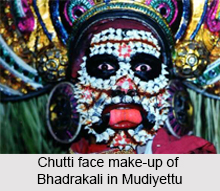 The costumes and make-up in Mudiyettu provide a colourful and imposing effect. The performers of Mudiyettu are all heavily made up and in gorgeous costumes with conventional facial paintings and tall head gears that give a touch of the supernatural to the characters. The "pettikaram" who is in charge of the make-up room, places a garland of Chethi flowers around the Muti, which represents the head and hair of the Goddess in Mudiyettu, Bhadrakali. The Chutti make-up, i.e., art work done on the face with coloured rice paste, forms an essential and distinct aspect in Mudiyettu. The Chutti Kuthal begins after the disfiguring and wiping of the Kalamezhuthu, the large multicoloured portrait of Bhadrakali drawn on the floor before the night rituals.
The costumes and make-up in Mudiyettu provide a colourful and imposing effect. The performers of Mudiyettu are all heavily made up and in gorgeous costumes with conventional facial paintings and tall head gears that give a touch of the supernatural to the characters. The "pettikaram" who is in charge of the make-up room, places a garland of Chethi flowers around the Muti, which represents the head and hair of the Goddess in Mudiyettu, Bhadrakali. The Chutti make-up, i.e., art work done on the face with coloured rice paste, forms an essential and distinct aspect in Mudiyettu. The Chutti Kuthal begins after the disfiguring and wiping of the Kalamezhuthu, the large multicoloured portrait of Bhadrakali drawn on the floor before the night rituals.
The artists get into the Chutti make-up with conventionalists using three items for the same, for the three different colours - lamp in coconut oil for black, rice paste with a touch of lime for white and "kumkumam" (vermillion) for red. Contemporarily, a green touch is also added blending yellow-hued Manayola mineral with blue. The make-up has undergone some development, from small pox scars and boils on the face to Chutti, which draws a similarity with the face make-up in Koodiyattam.
The make-up of Goddess Bhadrakali consists of a black face with white Chutti protruding out. She has long flowing locks, wearing an Uduthukettu, a loincloth put on in a peculiar fashion, taking the end of the long cloth between the legs and tucking it up behind at the waist. It is usually an ornamental red coloured vest with a long white cloth around the waist. The costume with its pleated effects at the back is a distinct highlight of Mudiyettu"s costume design. The costume beneath the waist is similar to that worn by the Chakiars for Chakiar Koothu.
The head gears are tall and all made of wood. They are very heavy, carved, gilded and jewelled. Glass pieces, peacock feathers and even the shells of beetles are pasted on them. On Kali`s headgear, the fierce face of the deity and a cobra`s hood are engraved. This element gives the character its fierce look. The abundant hair with finely torn tender coconut leaves, Kurutthola and prominent upper eye teeth, small pox boils with a ripe appearance, scarlet eyes, all give Bhadrakali the most fearful appearance.
The other characters too are all dressed up in an exotic and vibrant fashion with unique weirdness. The demons Daarika and Daanavendran have costumes and make-up which are similar to such characters in Kathakali, including the facial look. Koyimpata and sage Narada have costumes similar to those of folk theatre characters.
There are evident regional differences in the attire of Mudiyettu. In the Koratty style, Kali exhibits a bare torso, covered only by a breast-shaped plank while in the Keezhillam and the Pazhoor styles, she wears a full upper body dress. Similarly, in the Koratty style, demon Daarika`s muti resembles the Kathakali crown and his face paint resembles the Kathi Veshas of Kathakali.
Related Articles:
Mudiyettu, Kerala Ritual Theatre
Forms of Indian Theatre
Kerala
Folk Theatre of Kerala
Classical Indian Dance Drama
Koodiyattam, Folk Theatre of Kerala
Ritual Theatre in India
Goddess Bhadrakali
Performance of Mudiyettu
Comic Relief in Mudiyettu
Kathakali
Costumes and Make Up in Kathakali
Koothu




















